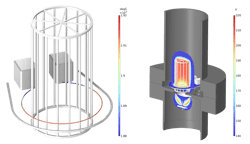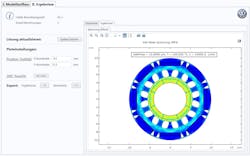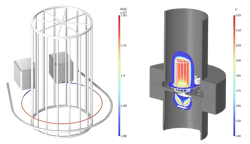Simulation Aids in Product Development and Design Across Industries
Modeling and simulation helps engineers across industries strengthen their product development process. Simulation can be used to improve on every step of the process, including material selection, geometry creation, performance prediction, virtual testing and design validation.
For instance, simulation software can be used early on in the design process to consider design feasibility, identify potential failures and guide decision-making. With the ability to easily modify different design metrics, designers can iterate faster and determine which variant leads to optimal performance. Moreover, by using computer-aided engineering (CAE) software with single-physics and multiphysics capabilities, engineers can develop models of real-world systems that accurately visualize the physics phenomenon or phenomena involved.
These models can also be used to study relevant interactions within a system or between a system and its surroundings, without having to rely on physical prototypes and test environments—or even enabling testing scenarios that are not possible to perform physically. With models that are grounded in real-world effects, designers can reduce the risk of unexpected product failures.
Here, we will look at three examples from different industries to show how simulation can accelerate the product development process, with a focus on design iteration, testing and performance prediction.
Automating the Testing of a Rotor
In product development, automating certain stages of the design process can help engineers save time and money. One way to automate a specific task in the design process is to build a simulation app based on the modeled design. Customized simulation apps enable engineers to focus on a specific task or problem and work with a user interface that has specialized functionality and relevant, easy-to-use features.
In addition, because the functionality and skill level of an app can be customized, apps can be designed in a way that is comprehensive to nonexperts, making simulation more accessible throughout an organization.
One company that employed simulation apps to improve its design process is automaker Volkswagen Kassel. The firm’s plant in Germany specializes in the development of electric drives, greatly contributing to the development of electric vehicles. A critical but time-consuming aspect of developing an electric drive is testing the strength of the rotor laminations. With the goal of creating an efficient tool that can be used to benchmark different designs, the simulation experts at Volkswagen created an app to automate part of the testing process.
The team determined that they could use the app to automate the load testing to include certain parameters that would be beneficial in their colleagues’ calculations and that could easily be changed, including the geometry, interference and number of active magnets. The app shortens the time it would take to perform strength and durability tests directly in a software program.
READ MORE: Designing the Software that Designs Electric Motors
Additionally, the app automatically generates a results report that includes a strength rating for laminated rotor sheet sections, helping different teams standardize the results (Fig. 1).
The app helped the Volkswagen team to more efficiently perform stress analyses of their rotor lamination designs, benchmark different designs and, ultimately, shorten the time to market.
Improving on a Benchmark Ionization Gauge Design
Part of the product development process is considering industry standards, which may involve looking at benchmark designs in the initial idea and concept design stage. Modeling and simulation can be used to refine benchmark designs and create improved designs that meet project goals.
As an example, instrument manufacturer INFICON (among other organizations) participated in an ionization gauge project with the goal of producing a new, better tool for quantifying pressure in high-vacuum or ultra-high-vacuum (HV/UHV) environments. INFICON used multiphysics simulation to create an ionization gauge model that generated values in close agreements with the test results from a benchmark prototype, enabling the team to determine how changing certain metrics, such as the sensitivity, affected the modeled design.
To start with their model, the team followed the standard modeling workflow of creating the model geometry and mesh and setting the boundary conditions. Their goal was to show the relationship between electron emissions and the filament temperature (Fig. 2). After simulating the thermal conditions, the team performed ray-tracing simulation, and the results were used to compute the sensitivity factor and refine the design in a way that better separated the paths of the ions and electrons. This, in turn, improved the design’s accuracy.
The team also decided to use a solid suspended disc as the filament rather than a thin wire (which standard gauges use) and to use stronger formed metal parts for the grid instead of the commonly used, delicate wire cage.
The prototypes proved that INFICON’s refined design performed better than the original benchmark gauge they considered: The new design reduced measurement uncertainty to below 1%, performed eight times better in terms of sensitivity, and delivered sensitivity repeatability performance that was 13 times better.
Virtually Predicting Speaker Performance
Predicting product performance virtually, prior to physical prototyping, can save the time and resources typically required for physical testing. However, this requires a virtual environment that produces accurate results and is flexible in regard to design modification. In this case, Dolby Laboratories used a single-physics, multimethod simulation approach to predict the acoustic coverage of its speakers and make design iterations to improve the coverage.
Dolby’s goal was to develop an ultrathin Dolby Atmos® enabled speaker (DAES) for home theater systems (Fig. 3). An integral part of this process was iterating a design that could overcome the challenges of making the technology slim enough that it complements thin, modern televisions while ensuring that the technology—despite its ultrathin design—still provides optimal sound coverage.
After considering different design concepts for their upward-firing speaker, one design change implemented by the team was the integration of an acoustic reflector into the design. With acoustic simulation, they compared the sound coverage of a speaker that includes an integrated reflector vs. a conventional design that does not include a reflector, finding that the design with the reflector offers wider coverage for ceiling reflection.
Using a hybrid finite element method (FEM) and boundary element method (BEM) approach, the team was able to then optimize the topology of the reflector and numerically analyze its directional response benefits. These analyses required considering, among other variables, the sound pressure distribution and ceiling height boundary conditions.
READ MORE: What’s The Difference Between FEM, FDM and FVM?
Following these analyses, the team created physical prototypes based on the simulation results that were tested and validated. The team was able to determine that including the acoustic reflector in a TV speaker provided a more immersive home audio experience.
Simulation Helps Streamline Product Development
As we have seen from the examples presented here, simulation can improve the product development process for a range of applications. Whether it’s through single-physics simulation, multiphysics analyses or simulation apps, the accuracy and versatility of simulation can help engineers optimize their designs and ensure that designs meet performance requirements and industry standards.
Bjorn Sjodin is senior vice president of product management at COMSOL.



